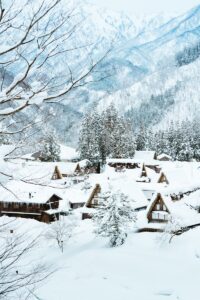冬の日本には、こたつや鍋、雪景色、正月行事など独特の文化や風物があります。
英語で海外の人に日本の冬を説明したいとき、どんな単語や表現を使えばよいでしょうか。
この記事では、日本の冬を表す特有の単語12個と、実際に使える英文例文、日本語訳をまとめました。
このリストを使えば、会話やSNS、メールで海外の人に日本の冬を自然に伝えられます。
1. Kotatsu(こたつ)
意味: A low table with a heater underneath and a blanket on top, used to stay warm in winter. It is a common furniture in Japanese homes.
(冬に暖を取るための、ヒーターがついた布団をかける低いテーブル。日本の家庭でよく使われます。)
例文: In Japan, families often sit together under a kotatsu to stay warm.
(日本では、家族がこたつに集まって暖を取ることがよくあります。)
2. Nabe / Hot Pot(鍋料理)
意味: A Japanese style hot pot dish where ingredients like vegetables, meat, tofu, and seafood are cooked together at the table and shared among people.
(野菜、肉、豆腐、魚介などをテーブルで煮ながら食べる日本の鍋料理。みんなで分けて食べます。)
例文: During cold winter evenings, friends gather to enjoy a nabe together.
(寒い冬の夜、友達と一緒に鍋を囲んで楽しみます。)
3. Yuzu Bath / Yuzu-yu(ゆず湯)
意味: A hot bath with yuzu citrus floating in the water, traditionally taken on the winter solstice for relaxation and good health.
(冬至の日に入る、ゆずの香りのする温かいお風呂。リラックスと健康のための習慣です。)
例文: On the winter solstice, many Japanese people take a yuzu bath to relax and stay healthy.
(冬至の日、多くの日本人はリラックスと健康のためにゆず湯に入ります。)
4. Osechi(おせち料理)
意味: Traditional New Year dishes with symbolic ingredients that represent luck, health, and happiness.
(正月に食べる伝統料理で、縁起を担ぐ食材が使われ、幸運や健康、幸福を象徴します。)
例文: Families prepare osechi for New Year to celebrate and wish for a good year.
(家族は新年を祝うため、そして一年の幸せを願っておせちを用意します。)
5. Mochi Pounding / Mochitsuki(餅つき)
意味: The traditional activity of pounding glutinous rice to make mochi (rice cakes), often done before New Year.
(もち米をついて餅を作る伝統行事。主に正月前に行われます。)
例文: Communities gather for mochitsuki to make rice cakes and celebrate the coming year.
(地域の人々は餅つきに集まり、餅を作って新しい年を祝います。)
6. Illumination(イルミネーション)
意味: Decorative lights displayed in cities, streets, and parks during winter, often creating a festive atmosphere.
(冬に街や公園、通りを彩る装飾ライト。お祭りのような雰囲気を作ります。)
例文: Tokyo is famous for its beautiful winter illuminations that light up the streets.
(東京は冬に街を彩る美しいイルミネーションで有名です。)
7. Kotatsu Orange(こたつ × みかん)
意味: Eating a mandarin orange while sitting under a kotatsu, a typical image of Japanese winter.
(こたつに入ってみかんを食べる、日本の冬らしい光景。)
例文: Many people enjoy a kotatsu orange, relaxing under the warm blanket with a sweet fruit.
( 多くの人がこたつみかんを楽しみ、暖かいこたつでみかんを食べながらくつろぎます。)
8. Bonenkai(忘年会)
意味: A year-end party held to forget the troubles of the past year and enjoy time with friends or coworkers.
(今年の嫌なことを忘れて、友人や同僚と楽しい時間を過ごす年末のパーティ。)
例文: Companies often hold bonenkai in December to celebrate the year and relax together.
(企業では年を締めくくり、一緒にリラックスするために12月に忘年会を開きます。)
9. Hatsuhinode(初日の出)
意味: The first sunrise of the New Year, watched for good luck and blessings.
(一年で最初の朝日で、縁起を担ぎ見る行事。)
例文: Many Japanese people go to the beach or mountains to see the hatsuhinode on January 1st.
(多くの日本人は元日に初日の出を見るため、海や山に行きます。)
10. Yukimi(雪見)
意味: The act of enjoying snow scenery, either from indoors or outdoors.
(雪景色を楽しむこと。屋内や屋外から眺めます。)
例文: During winter, many people enjoy yukimi by looking at snow from their window or garden.
(冬には、多くの人が窓や庭から雪景色を眺めて雪見を楽しみます。)
11. Yukiguni(雪国)
意味: Regions in Japan where heavy snowfall is common during winter.
(冬に大雪がよく降る地域のこと。)
例文: In Yukiguni, heavy snowfall is common and people wear warm boots and coats.
(雪国では、大雪がよく降り、人々は暖かいブーツやコートを着ます。)
12. Fuyu Matsuri / Winter Festival(冬祭り)
意味: Winter festivals featuring snow or ice sculptures, food, and traditional events.
(雪や氷の彫刻、食べ物、伝統行事を楽しむ冬の祭り。)
例文: Many cities hold fuyu matsuri with ice sculptures, fireworks, and winter food.
(多くの都市で、氷の彫刻や花火、冬の食べ物を楽しむ冬祭りが開かれます。)
